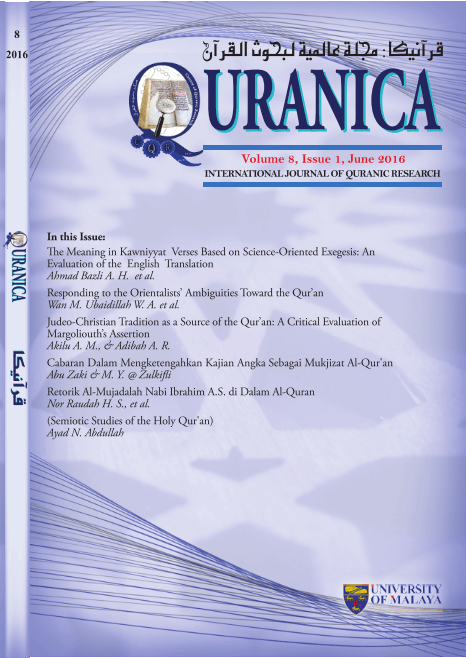The Meaning in Kawniyyat Verses based on Science-Oriented Exegesis: An Evaluation of the English Translation
Main Article Content
Abstract
One of the process requirements in the translation of the meaning of Quran is that it must be done by a committee consisting of experts in the field of knowledge related to the Quran such as Arabic language, the target language, the interpretation of Quran and other disciplines such as history, geography, chemistry, biology, medicine and others. It is obvious that Quran is not merely discussing the question of law, but also contains elements of various fields. Kawniyyat verses (verses related to creation) are the Quranic verses which have been typically discussed on the issue of the translation of the meaning of Quran. This is because kawniyyat verses indirectly contain elements of science that require the expertise of those involved in the field to provide the exact meaning so that the translations are done in line with the facts of modern science. The objective of this study was to evaluate the meaning of the translation of kawniyyat verses in The Meaning of the Holy Quran by Abdullah Yusuf Ali based on the facts of contemporary science to find out the compatibility between them. In this article, the analysis of the translation of meaning of the verses of Holy Qur’an utilised science-oriented exegesis (tafsir ‘ilmi) to determine whether the translation of meaning matches the modern science facts. The suitable meaning of the verse translation will be proposed then. The result showed some additional values in the translation of meaning of the word ‘alaqah in the verse 14 of Sura Al-Mu’minun which is translated into “blood layer/clot”, while the more accurate meaning should be “blood layer that characterizes a leech” and the word al-nahl in the verse 68 of Sura Al-Nahl which is translated into “Bee”, while the more accurate meaning should be “female bees”.
Downloads
Article Details
Disclaimer
QURANICA makes every effort to ensure the accuracy of all its contents. However, opinions, discussions, views and recommendations are expressed in this journal do not necessarily reflect the official policy of QURANICA or views of its editors or publishers. Therefore, QURANICA and its publishers will not be liable for any controversy may be arisen. The journal reserves the right, at its sole discretion, to change its terms and conditions of publications.
Copyright
It is a condition of publication that manuscript submitted to the journal have not been published, accepted for publication, nor simultaneously submitted for publication elsewhere. By submitting a manuscript, the author(s) agrees that copyright for the article is transferred to the publisher, if and when the manuscript is accepted for publication.
